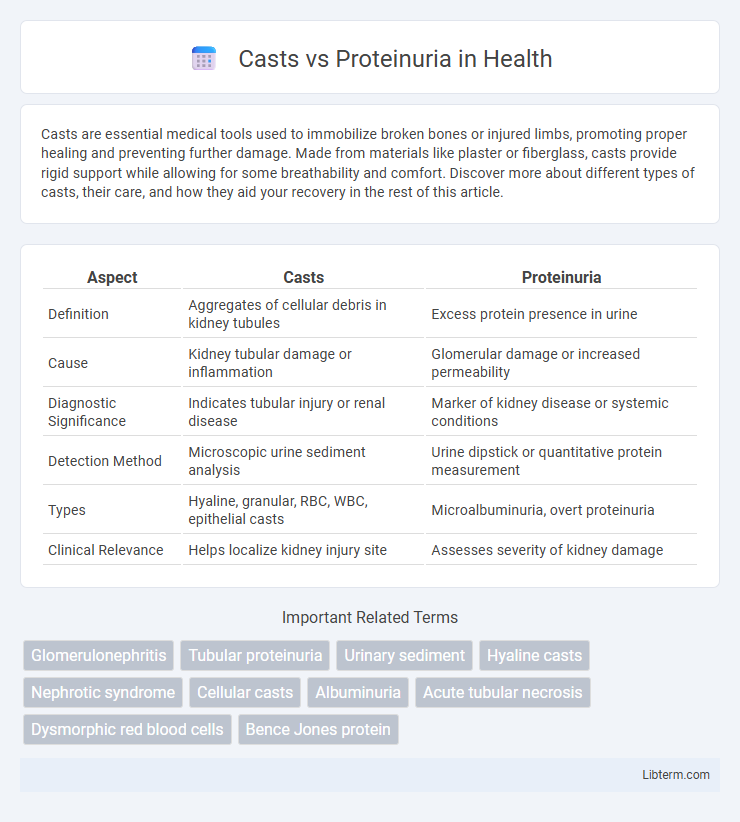Casts are essential medical tools used to immobilize broken bones or injured limbs, promoting proper healing and preventing further damage. Made from materials like plaster or fiberglass, casts provide rigid support while allowing for some breathability and comfort. Discover more about different types of casts, their care, and how they aid your recovery in the rest of this article.
Table of Comparison
| Aspect | Casts | Proteinuria |
|---|---|---|
| Definition | Aggregates of cellular debris in kidney tubules | Excess protein presence in urine |
| Cause | Kidney tubular damage or inflammation | Glomerular damage or increased permeability |
| Diagnostic Significance | Indicates tubular injury or renal disease | Marker of kidney disease or systemic conditions |
| Detection Method | Microscopic urine sediment analysis | Urine dipstick or quantitative protein measurement |
| Types | Hyaline, granular, RBC, WBC, epithelial casts | Microalbuminuria, overt proteinuria |
| Clinical Relevance | Helps localize kidney injury site | Assesses severity of kidney damage |
Introduction to Casts and Proteinuria
Casts are cylindrical structures formed in the renal tubules composed of Tamm-Horsfall protein, cellular elements, or lipids, serving as markers for various kidney conditions. Proteinuria refers to the abnormal presence of proteins, primarily albumin, in the urine, indicating glomerular or tubular damage. Differentiating between casts and proteinuria provides critical insights into the underlying renal pathology and guides clinical diagnosis and management.
Understanding Urinary Casts: Types and Significance
Urinary casts are cylindrical structures formed in the renal tubules, composed of Tamm-Horsfall protein and cellular elements, serving as crucial indicators of kidney pathology. Different cast types, such as hyaline, granular, red blood cell, and epithelial casts, correspond to varying renal conditions, helping differentiate between glomerular, tubular, and interstitial diseases. Proteinuria represents excess protein in urine, often correlating with the presence of specific casts, where the type and quantity of casts provide valuable insight into the severity and nature of renal injury.
What is Proteinuria? Causes and Clinical Implications
Proteinuria is the presence of excess proteins, primarily albumin, in the urine, often indicating kidney damage or disease. Common causes include glomerulonephritis, diabetic nephropathy, hypertension, and infections affecting the renal filtration barrier. Clinically, persistent proteinuria signals impaired kidney function, increases the risk of chronic kidney disease progression, and necessitates further diagnostic evaluation to guide treatment.
Pathophysiology: How Casts and Proteinuria Form
Casts form in the renal tubules when proteins, cells, or debris aggregate and solidify in the presence of Tamm-Horsfall protein under conditions of altered urine flow or pH. Proteinuria results from increased glomerular permeability or impaired tubular reabsorption, allowing excess plasma proteins like albumin to leak into the urine. The presence of casts often indicates tubular or glomerular damage, while proteinuria reflects glomerular filtration barrier disruption or tubular dysfunction.
Diagnostic Approaches: Detecting Casts and Proteinuria
Detecting casts and proteinuria involves specific diagnostic approaches crucial for kidney disease evaluation. Microscopic urinalysis identifies urinary casts, providing insights into tubular damage or inflammation, while dipstick tests and quantitative protein measurements detect proteinuria, indicating glomerular injury or increased permeability. Combining these methods enhances diagnostic accuracy in assessing renal pathology and guiding clinical management.
Clinical Conditions Associated with Casts
Casts in urine primarily indicate tubular damage and are associated with clinical conditions like acute tubular necrosis, glomerulonephritis, and pyelonephritis. The presence of granular, waxy, or epithelial casts suggests varying degrees of kidney injury and inflammation. Proteinuria, while indicating glomerular damage, is often accompanied by specific casts that help differentiate between types of renal pathology.
Diseases Commonly Linked to Proteinuria
Proteinuria, characterized by excess protein in the urine, is commonly linked to kidney diseases such as glomerulonephritis, diabetic nephropathy, and hypertensive nephrosclerosis. Casts, tubular protein accumulations visible under microscopy, help differentiate the underlying cause of proteinuria by indicating specific kidney damage types like red blood cell casts in glomerulonephritis or granular casts in acute tubular necrosis. Identifying proteinuria alongside cast types supports accurate diagnosis and guides targeted treatment strategies for renal pathologies.
Casts vs Proteinuria: Key Differences
Casts are cylindrical structures formed in the renal tubules, typically composed of proteins, cells, or cellular debris, indicating specific kidney conditions, while proteinuria refers to an abnormal amount of protein in the urine, suggestive of glomerular or tubular damage. Casts provide more detailed information about the type and location of kidney injury, such as red blood cell casts in glomerulonephritis or granular casts in acute tubular necrosis, whereas proteinuria primarily signals increased permeability of the glomerular filtration barrier. Understanding these differences is crucial for accurate diagnosis and management of renal diseases.
Prognostic Value: Casts Compared to Proteinuria
Casts in urine sediment, particularly granular and red blood cell casts, have a higher prognostic value than proteinuria alone in kidney disease, indicating more severe tubular injury and active glomerular pathology. Proteinuria reflects glomerular damage and is a well-established marker for chronic kidney disease progression, but the presence of specific casts can provide additional insights into the type and severity of renal injury. Combining cast analysis with quantitative proteinuria assessment improves risk stratification and guides targeted clinical management.
Summary: Clinical Relevance and Future Perspectives
Casts and proteinuria are critical biomarkers in diagnosing and monitoring kidney diseases, with casts indicating tubular damage and proteinuria reflecting glomerular filtration barrier dysfunction. Accurate differentiation and quantification of these markers enhance clinical decision-making, enabling tailored therapeutic strategies and early intervention in renal pathology. Future perspectives emphasize the integration of advanced biomarkers and machine learning algorithms to improve diagnostic precision and prognostic assessments in nephrology.
Casts Infographic

 libterm.com
libterm.com